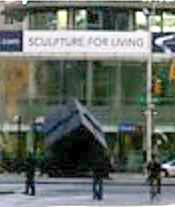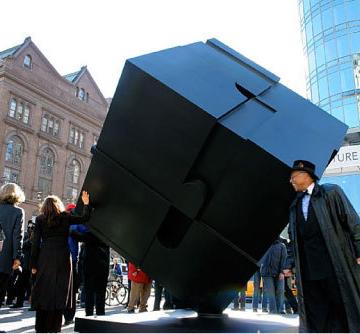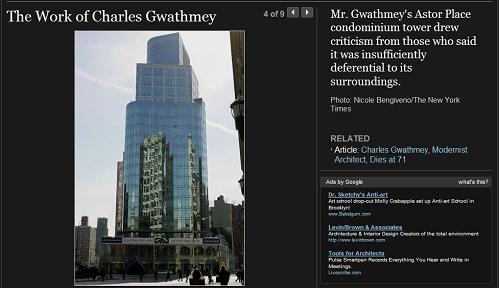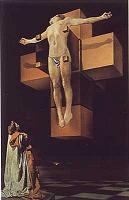See as well other posts tagged Modernism.
Friday, May 11, 2018
Friday, January 5, 2018
Subway Art for Plato’s Ghost
Saturday, May 23, 2015
Art
"Is Fiction the Art of Lying?" by Mario Vargas Llosa
The above link is to a Google Books Search for references
to a 1984 piece in The New York Times .
To find the Times 's own version, change "Lying" to "Living."
"We tell ourselves stories in order to live." — Joan Didion
Thursday, February 13, 2014
Plan 9
The final link in today's previous post leads to
a post whose own final link leads to…
Thursday, December 13, 2012
|
Thursday, June 20, 2013
ART WARS: Chesterton Thursday
The New York Times philosophy column "The Stone"
last evening had an essay on art by a sarcastic anarchist,
one Crispin Sartwell—
"… whole generations of art lovers have been
trained in modernist dogma, and arts institutions’
access to various forms of state or foundation
support depend on it completely. One goes to
the museum to gasp at stunning works of
incomparable, super-human genius by beings
who are infinitely more exalted and important
than the mere humans staring at their paintings.
That’s why ordinary people staring at a Picasso
(allegedly) experience a kind of transcendence
or re-articulation of their lives and world."
Cubism Re-Articulated:
Click image for some backstory.
(IMAGE: Walter Gropius and Froebel's Third Gift,
from a Google image search today)
Background: Cubism in this journal and
Pilate Goes to Kindergarten.
Related material: Chesterton + Thursday in this journal.
Thursday, December 13, 2012
Space
… The sequel to Vibrations
Charles Taylor, "Epiphanies of Modernism,"
Chapter 24 of Sources of the Self
(Cambridge U. Press, 1989, p. 477) —
“… the object sets up a kind of
frame or space or field
within which there can be epiphany.”
Or place.
See A Prince of Darkness
and "A Clean, Well-Lighted Place."
Wednesday, December 12, 2012
Chromatic Plenitude
(Continued from 2 PM ET Tuesday)
“… the object sets up a kind of frame or space or field
within which there can be epiphany.”
— Charles Taylor, "Epiphanies of Modernism,"
Chapter 24 of Sources of the Self
(Cambridge U. Press, 1989, p. 477)
"The absolute consonance is a state of chromatic plenitude."
"… the nearest precedent might be found in Becky Sharp .
The opening of the Duchess of Richmond's ball,
with its organization of strong contrasts and
display of chromatic plenitude, presents a schema…."
— Scott Higgins, Harnessing the Technicolor Rainbow:
Color Design in The 1930s , University of Texas Press,
2007, page 142
Note the pattern on the dance floor.
(Click for wider image.)
"At the still point…" — Four Quartets
Friday, July 15, 2011
Spider Women
"Of course, the aesthetic program
of cultural modernism
has long been summed up
by the maxim épater la bourgeoisie."
— The New York Times
Sunday Book Review, July 17
Examples:
"This Extreme and Difficult Sense of Spectacular Representation:
Antonin Artaud's Ontology of 'Live'," by Deborah Levitt
of the New School (See the noon post of July 13), as well as…
and, from mathematician Ellen Gethner's home page—
See also Sunday Dinner, A Link for Sunrise, and Inside CBS News.
Tuesday, June 28, 2011
ART WARS continued
See the signature link in last night's post for a representation of Madison Avenue.
For a representation by Madison Avenue, see today's New York Times—

"As a movement Pop Art came and went in a flash, but it was the kind of flash that left everything changed. The art public was now a different public— larger, to be sure, but less serious, less introspective, less willing or able to distinguish between achievement and its trashy simulacrum. Moreover, everything connected with the life of art— everything, anyway, that might have been expected to offer some resistance to this wholesale vulgarization and demoralization— was now cheapened and corrupted. The museums began their rapid descent into show biz and the retail trade. Their exhibitions were now mounted like Broadway shows, complete with set designers and lighting consultants, and their directors pressed into service as hucksters, promoting their wares in radio and television spots and selling their facilities for cocktail parties and other entertainments, while their so-called education programs likewise degenerated into sundry forms of entertainment and promotion. The critics were co-opted, the art magazines commercialized, and the academy, which had once taken a certain pride in remaining aloof from the blandishments of the cultural marketplace, now proved eager to join the crowd— for there was no longer any standard in the name of which a sellout could be rejected. When the boundary separating art and fashion was breached, so was the dividing line between high art and popular culture, and upon all those institutions and professions which had been painstakingly created to preserve high art from the corruptions of popular culture. The effect was devastating. Some surrendered their standards with greater alacrity than others, but the drift was unmistakable and all in the same direction— and the momentum has only accelerated with the passage of time."
— Hilton Kramer, The Triumph of Modernism: The Art World, 1985-2005 , publ. by Ivan R. Dee on Oct. 26, 2006, pp. 146-147
Related material— Rubik in this journal, Exorcist in this journal, and For the Class of '11.
Saturday, January 8, 2011
True Grid (continued)
"Rosetta Stone" as a Metaphor
in Mathematical Narratives
For some backgound, see Mathematics and Narrative from 2005.
Yesterday's posts on mathematics and narrative discussed some properties
of the 3×3 grid (also known as the ninefold square ).
For some other properties, see (at the college-undergraduate, or MAA, level)–
Ezra Brown, 2001, "Magic Squares, Finite Planes, and Points of Inflection on Elliptic Curves."
His conclusion:
When you are done, you will be able to arrange the points into [a] 3×3 magic square,
which resembles the one in the book [5] I was reading on elliptic curves….
This result ties together threads from finite geometry, recreational mathematics,
combinatorics, calculus, algebra, and number theory. Quite a feat!
5. Viktor Prasolov and Yuri Solvyev, Elliptic Functions and Elliptic Integrals ,
American Mathematical Society, 1997.
Brown fails to give an important clue to the historical background of this topic —
the word Hessian . (See, however, this word in the book on elliptic functions that he cites.)
Investigation of this word yields a related essay at the graduate-student, or AMS, level–
Igor Dolgachev and Michela Artebani, 2009, "The Hesse Pencil of Plane Cubic Curves ."
From the Dolgachev-Artebani introduction–
In this paper we discuss some old and new results about the widely known Hesse
configuration of 9 points and 12 lines in the projective plane P2(k ): each point lies
on 4 lines and each line contains 3 points, giving an abstract configuration (123, 94).
PlanetMath.org on the Hesse configuration—

A picture of the Hesse configuration–

(See Visualizing GL(2,p), a note from 1985).
Related notes from this journal —
From last November —
|
From the December 2010 American Mathematical Society Notices—
Related material from this journal— Consolation Prize (August 19, 2010) |
From 2006 —
|
Sunday December 10, 2006
“Function defined form, expressed in a pure geometry
– J. G. Ballard on Modernism
“The greatest obstacle to discovery is not ignorance –
— Daniel J. Boorstin, |
Also from 2006 —
|
Sunday November 26, 2006
Rosalind Krauss "If we open any tract– Plastic Art and Pure Plastic Art or The Non-Objective World , for instance– we will find that Mondrian and Malevich are not discussing canvas or pigment or graphite or any other form of matter. They are talking about Being or Mind or Spirit. From their point of view, the grid is a staircase to the Universal, and they are not interested in what happens below in the Concrete. Or, to take a more up-to-date example…."
"He was looking at the nine engravings and at the circle,
"And it's whispered that soon if we all call the tune
The nine engravings of The Club Dumas
An example of the universal*– or, according to Krauss,
"This is the garden of Apollo, the field of Reason…."
For more on the field of reason, see
A reasonable set of "strange correspondences" Unreason is, of course, more popular. * The ninefold square is perhaps a "concrete universal" in the sense of Hegel: "Two determinations found in all philosophy are the concretion of the Idea and the presence of the spirit in the same; my content must at the same time be something concrete, present. This concrete was termed Reason, and for it the more noble of those men contended with the greatest enthusiasm and warmth. Thought was raised like a standard among the nations, liberty of conviction and of conscience in me. They said to mankind, 'In this sign thou shalt conquer,' for they had before their eyes what had been done in the name of the cross alone, what had been made a matter of faith and law and religion– they saw how the sign of the cross had been degraded."
– Hegel, Lectures on the History of Philosophy ,
"For every kind of vampire, |
And from last October —
|
Friday, October 8, 2010
Starting Out in the Evening This post was suggested by last evening's post on mathematics and narrative and by Michiko Kakutani on Vargas Llosa in this morning's New York Times .
"One must proceed cautiously, for this road— of truth and falsehood in the realm of fiction— is riddled with traps and any enticing oasis is usually a mirage."
– "Is Fiction the Art of Lying?"* by Mario Vargas Llosa,
* The Web version's title has a misprint— |
Saturday, March 6, 2010
Deconstructing Alice
Alyssa is Wonderland
Manohla Dargis in The New York Times yesterday—
“Of course the character of Carroll’s original Alice is evident in each outrageous creation she dreams up in ‘Wonderland’ and in the sequel, ‘Through the Looking-Glass,’ which means that she’s a straight man to her own imagination. (She is Wonderland.)”

From Inside the White Cube—
“The sacramental nature of the space becomes clear, and so does one of the great projective laws of modernism: as modernism gets older, context becomes content. In a peculiar reversal, the object introduced into the gallery ‘frames’ the gallery and its laws.”
From Yogi Berra–
“When you come to a fork in the road, take it.”
Related material: For Baron Samedi and…
Wednesday, March 3, 2010
Plato’s Ghost
Jeremy Gray, Plato's Ghost: The Modernist Transformation of Mathematics, Princeton, 2008–
"Here, modernism is defined as an autonomous body of ideas, having little or no outward reference, placing considerable emphasis on formal aspects of the work and maintaining a complicated— indeed, anxious— rather than a naïve relationship with the day-to-day world, which is the de facto view of a coherent group of people, such as a professional or discipline-based group that has a high sense of the seriousness and value of what it is trying to achieve. This brisk definition…."
Brisk? Consider Caesar's "The die is cast," Gray in "Solomon's Cube," and yesterday's post—
This is the group of "8 rigid motions
generated by reflections in midplanes"
of Solomon's Cube.
Related material:
"… the action of G168 in its alternative guise as SL(3; Z/2Z) is also now apparent. This version of G168 was presented by Weber in [1896, p. 539],* where he attributed it to Kronecker."
— Jeremy Gray, "From the History of a Simple Group," in The Eightfold Way, MSRI Publications, 1998
Here MSRI, an acronym for Mathematical Sciences Research Institute, is pronounced "Misery." See Stephen King, K.C. Cole, and Heinrich Weber.
*H. Weber, Lehrbuch der Algebra, Vieweg, Braunschweig, 1896. Reprinted by Chelsea, New York, 1961.
Monday, September 28, 2009
Monday September 28, 2009
for Germany
See Annals of Aesthetics,
January 13, 2009,
which features the following
example of modernism:
… and for readers of
the Sunday New York Times …
The book's author, Audrey Niffenegger, has stated that her title refers to "the doubling and twinning and opposites" that are "essential to the theme and structure of the book." For examples of doubling, twinning, and opposites that I prefer to Niffenegger's, see this journal's Saturday and Sunday entries.
Fans of the New York Times's cultural coverage may prefer Niffenegger's own art work. They may also enjoy images from the weekend's London Art Book Fair that suggested the rather different sort of book in Saturday's entry.
Monday, August 31, 2009
Monday August 31, 2009
Ask a Stupid Question
continued from
last Wednesday…
|
"Did you see more glass?"

|
Wednesday, August 26,
was the date of death
for Hyman Bloom.
Related material:
An entry in this journal linked to twice on the date of Bloom's death–
Art and Man at Yale–
and an illustrated entry from this journal on the date of the "Mystic" article–
Elements of Geometry.
where modernism triumphs.
As in the cases of the pyramids
and the Taj Mahal, the Siegfried line
and the Atlantic wall, death always
calls on the very best architects."
– J. G. Ballard,
"A Handful of Dust"
Tuesday, August 4, 2009
Tuesday August 4, 2009
The New York Times today
on architect Charles Gwathmey,
who died Monday:
"Mr. Gwathmey's Astor Place
condominium tower drew
criticism from those who
said it was insufficiently
deferential to its
surroundings."
Astor Place tower
(click to enlarge):
Surroundings:

The above sculpture,
popularly known as
The Borg Cube,
appeared here on
Saturday:

The Borg Cube, with
Cooper Union at left
For deferential remarks, see
Annals of Collective Consciousness.
See also the link
from noon today to
Nobel Prize Day, 2006,
and the link there to
J. G. Ballard on modernism.
"So, there is one place
where modernism triumphs.
As in the cases of the pyramids
and the Taj Mahal, the Siegfried line
and the Atlantic wall, death always
calls on the very best architects."
— J. G. Ballard,
"A Handful of Dust"
Friday, May 22, 2009
Friday May 22, 2009
New York Times
banner this morning:
Related material from
July 11, 2008:

|
The HSBC Logo Designer — Henry Steiner
Born in Austria and raised in New York, Steiner was educated at Yale under Paul Rand and attended the Sorbonne as a Fulbright Fellow. He is a past President of Alliance Graphique Internationale. Other professional affiliations include the American Institute of Graphic Arts, Chartered Society of Designers, Design Austria, and the New York Art Directors' Club. His Cross-Cultural Design: Communicating in the Global Marketplace was published by Thames and Hudson (1995). |
|
Charles Taylor,
"Epiphanies of Modernism," Chapter 24 of Sources of the Self (Cambridge U. Press, 1989, p. 477):
"… the object sets up
See also Talking of Michelangelo.
|
Related material suggested by
an ad last night on
ABC's Ugly Betty season finale:
Diamond from last night's
Log24 entry, with
four colored pencils from
Diane Robertson Design:

See also
A Four-Color Theorem.
Friday, February 20, 2009
Friday February 20, 2009
The Cross
of Constantine
mentioned in
this afternoon's entry
"Emblematizing the Modern"
was the object of a recent
cinematic chase sequence
(successful and inspiring)
starring Mira Sorvino
at the Metropolitan
Museum of Art.
In memory of
Dr. Hunter S. Thompson,
dead by his own hand
on this date
four years ago —
There is
another sort of object
we may associate with a
different museum and with
a modern Constantine …
See "Art Wars for MoMA"
(Dec. 14, 2008).
This object, modern
rather than medieval,
is the ninefold square:
It may suit those who,
like Rosalind Krauss
(see "Emblematizing"),
admire the grids of modern art
but view any sort of Christian
cross with fear and loathing.
For some background that
Dr. Thompson might appreciate,
see notes on Geometry and Death
in this journal, June 1-15, 2007,
and the five Log24 entries
ending at 9 AM Dec. 10. 2006,
which include this astute
observation by J. G. Ballard:
Selah.
Monday, February 25, 2008
Monday February 25, 2008
Yale University Press
discussed in Log24
four years ago today:
Click on image for details.
The book is titled
Inside Modernism:
Relativity Theory,
Cubism, Narrative.
For a narrative about relativity
and cubes, see Knight Moves.
Related material:
Geek chic in
this week’s New Yorker—
“… it takes a system of symbols
to make numbers precise–
to ‘crystallize’ them….”
— and a mnemonic for three
days in October 2006
following a memorial to
the Amish schoolchildren
slain that month:
Sunday, December 10, 2006
Sunday December 10, 2006
on Nobel Prize Day
"Time and chance
happeneth to them all."
— Ecclesiastes

The number 048
may be interpreted
as referring to…

"Function defined form,
expressed in a pure geometry
that the eye could easily grasp
in its entirety."
— J. G. Ballard on Modernism
(The Guardian, March 20, 2006)
"The greatest obstacle to discovery
is not ignorance —
it is the illusion of knowledge."
— Daniel J. Boorstin,
Librarian of Congress,
quoted in Beyond Geometry
Wednesday, February 25, 2004
Wednesday February 25, 2004
Modernism as a Religion
In light of the controversy over Mel Gibson's bloody passion play that opens today, some more restrained theological remarks seem in order. Fortunately, Yale University Press has provided a
From a review by Adam White Scoville of Iain Pears's novel titled An Instance of the Fingerpost:
"Perhaps we are meant to see the story as a cubist retelling of the crucifixion, as Pilate, Barabbas, Caiaphas, and Mary Magdalene might have told it. If so, it is sublimely done so that the realization gradually and unexpectedly dawns upon the reader. The title, taken from Sir Francis Bacon, suggests that at certain times, 'understanding stands suspended' and in that moment of clarity (somewhat like Wordsworth's 'spots of time,' I think), the answer will become apparent as if a fingerpost were pointing at the way."
Recommended related
By others:
Inside Modernism: Relativity Theory, Cubism, Narrative, Thomas Vargish and Delo E. Mook, Yale University Press, 1999
Signifying Nothing: The Fourth Dimension in Modernist Art and Literature
Corpus Hypercubus,
by Dali. Not cubist,
perhaps "hypercubist."
By myself:
The Crucifixion of John O'Hara
The Da Vinci Code and Symbology at Harvard
Material that is related, though not




















 He is an internationally recognized corporate identity consultant. Based in Hong Kong, his work for clients such as HongkongBank, IBM and Unilever is a major influence in Pacific Rim design.
He is an internationally recognized corporate identity consultant. Based in Hong Kong, his work for clients such as HongkongBank, IBM and Unilever is a major influence in Pacific Rim design.




